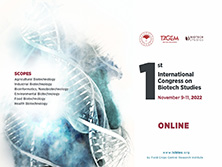Biotech Studies
Response surface methodology based optimization studies about bioethanol production by Candida boidinii from pumpkin residues
2 Biology Department, Science Faculty, Ankara University, 06100, Beşevler, Ankara, Türkiye DOI : 10.38042 - For sustainable bioethanol production, the investigation of novel fermentative microorganisms and feedstocks is crucial. In this context, the goals of the current study are suggesting pumpkin residues as new raw material for bioethanol production and investigating the fermentative capacity of the Candida boidinii, which is a newly isolated yeast from sugar factory wastes. Response surface methodology was used to determine the effect of enzyme (cellulase and hemicellulase) concentration and enzymatic hydrolysis time. The maximum bioethanol concentration was 29.19 g/L when fermentation parameters were optimized. However, it is revealed that enzymatic hydrolysis and hydrolysis duration (48-72 h) have significant effects on reducing sugar concentration. The highest reducing sugar was 108.86 g/L when the 20% initial pumpkin residue was hydrolyzed at 37.5 FPU/g substrate cellulase and 37.5 U/mL hemicellulase at the end of 72 h. Under these optimized conditions, the bioethanol production of C. boidinii increased by 22.91% and reached 35.88 g/L. This study shows pumpkin residues are promising feedstocks and C. boidinii is a suitable microorganism for efficient bioethanol production. Keywords : Candida boidinii Saccharomyces cerevisiae Pumpkin residues Bioethanol Response surface Methodology















